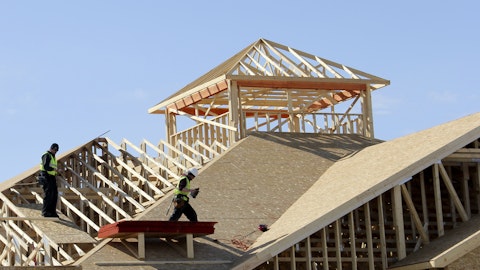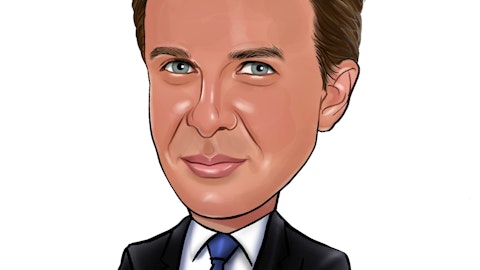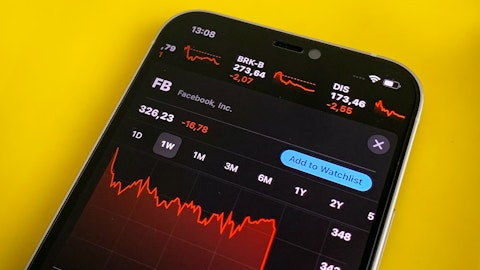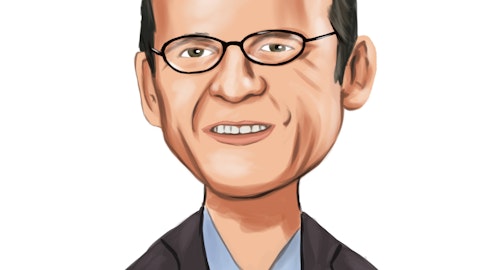Armstrong World Industries, Inc. (NYSE:AWI) Q4 2022 Earnings Call Transcript February 26, 2023
Operator: Good day, and thank you for standing by. Welcome to the Armstrong World Industries, Inc. Fourth Quarter 2022 Earnings Conference Call. Please be advised that today’s conference is being recorded. I would now like to hand the conference over to your speaker today, Theresa Womble, Vice President of Investor Relations.
Theresa Womble: Thank you, and welcome, everyone, to our call this morning. On today’s call, Vic Grizzle, our CEO; and Chris Calzaretta, our CFO will discuss Armstrong World Industries fourth quarter 2022 results, and our outlook for 2023. To accompany these remarks, we have provided a presentation that is available on the IR section of the Armstrong World Industries website. Our discussion of operating and financial performance will include non-GAAP financial measures within the meaning of SEC’s Regulation G. A reconciliation of these measures with the most directly comparable GAAP measure is included in the earnings press release and in the appendix of the presentation. During this call, we will be making forward-looking statements that represent the view we have of our financial and operational performance as of today’s date, February 21, 2023.
These statements involve risks and uncertainties that may differ materially from those expected or implied. We provide a detailed discussion of our risks and uncertainties in our SEC filings, including the 10-K that was also filed this morning. We undertake no obligation to update any forward-looking statements beyond what is required by applicable securities law. With that, I will now turn the call over to Vic.
Vic Grizzle: Thank you, Theresa, and good morning, and thank you all for joining our call today. Today, we reported solid fourth quarter and full-year results, and what continues to be a challenging environment for many of our end markets. Fourth quarter net sales increased 8% and adjusted EBITDA rose 5%. For the full-year, net sales increased 11% from 2021 results and EBITDA improved 4%, driven by strong AUV growth in Mineral Fiber, strong Architectural Specialty sales and earnings growth, and as well as solid productivity gains in our mineral fiber plants. These results were at the low end of our expectations heading into the fourth quarter, primarily due to the lower-than-expected WAVE equity earnings. On a continuation of inventory corrections on grid products.
All-in-all, I’m proud of the work our teams did to close out what was a challenging year on many levels. Taking a closer look at our segments. Let me begin with our Architectural Specialties segment, where we achieved 18% sales growth in the fourth quarter and 20% for the full-year. This marks the ninth consecutive quarter of double-digit year-over-year sales growth in the specialty segment. These outstanding results were driven by strong broad-based demand for both our standard and custom products. While demand for these products span server verticals, we saw particular strength in transportation and higher education projects. We’ve delivered strong growth in the Architectural Specialties segment by leveraging the new product platforms that we’ve been acquiring over the past several years, and the design capabilities we’ve built over the last decade.
This has allowed us to create the scale and reach of Armstrong to further penetrate the specialty ceiling and wall category, participating in more spaces and commercial buildings and importantly, in larger, more complex jobs. One of the projects and true highlights of the quarter that best illustrates our scale and capability as a competitive advantage was the completion of the Kansas City International Airport project. As you can imagine, airport projects are large, complex, and contain many design challenges. Later to open next week, the Kansas City Airport is likely to generate tremendous interest from the design community for the unique look and feel, our products have helped achieve there. As you will notice, when you see the work there, the design, particularly with our wood products, is simply inspiring.
It’s also a project that tapped our broad and industry-leading portfolio, utilizing multiple Armstrong products from lots of wood to metal, felt, and mineral fiber products. This project also demanded new technology to meet heightened product safety standards that I’m confident few companies would have been able to meet. Again, a further testament to the innovation and material sciences capabilities we have here at Armstrong. It’s a combination of all these factors and capabilities along with the passion of our team that is enabling our continued success in this growing category. And further to this point, we were just awarded the new terminal at the Pittsburgh airport, which is our largest project ever in the Americas. It will involve multiple products from our portfolio, including custom wood look metal, MetalWorks panels, our Moz column covers, and mineral fiber and WAVE grid products, an incredible win and again, a confirmation of the competitive advantage we’ve built with our unique size, scale, and capability.
Turning to the Mineral Fiber segment. We generated solid top line growth driven by a second year of robust AUV growth at double-digit levels. This was driven primarily by like-for-like pricing, and secondarily, positive product mix with the fourth quarter achieving the strongest fixed contribution of the year. Our AUV execution allowed us to successfully manage inflationary pressures on raw materials and natural gas. As we’ve said before, pricing is an affirmation of the value you create for customers, and we never take this for granted, and are committed to being the best-in-class in quality, innovation, and speed, all helping to differentiate us in the market and to support our price achievement. Our Mineral Fiber plants also continue to execute and run well, delivering strong productivity, which helped offset inflationary pressures.
Our production teams continue to deploy lean manufacturing practices and execute a variety of efficiency initiatives every year, while still maintaining excellent quality and service levels. And we continue to innovate and introduce new products that help drive consistent product mix benefits. I continue to be impressed with how our plant teams adapt and deliver results in all market conditions. As we’ve reported, the most significant headwind throughout the year was lower-than-expected Mineral Fiber volumes and soft WAVE equity earnings tied to weaker volumes. The weakness in Mineral Fiber volumes was driven primarily by inventory corrections early in the year and then weakening market demand in the second half of the year. WAVE earnings were challenged throughout the year by inventory corrections as steel prices began to turn, exacerbated by the deceleration in market demand that began in the third quarter and continued into the fourth quarter.
We were certainly disappointed in how market demand shaped up in 2022. After having a strong outlook to begin the year. You’ll remember, we came into the year expecting a positive market tailwind driving low to mid-single-digit Mineral Fiber volumes. That was based on strong Dodge bidding activity, increasing return to office activity and improvements in supply chains against a positive macroeconomic backdrop with 2022 GDP forecast at 3.9% at the beginning in January. Conditions for commercial construction deteriorated from the repercussions of the war in the Ukraine, including rapid inflation, leading to rising interest rates, and eventually economic uncertainty. Macroeconomic growth outlooks also weakened throughout the year with real GDP in the fourth quarter at the level of the year.
Consequently, demand in our key markets decelerated and ultimately turned negative towards the end of the year. This resulted in weaker industry indicators with Dodge bidding activity turning negative and ABI remaining below 50 for the last three months. Against this softer backdrop, there are areas of notable strength. Within our key verticals that are worth noting, we’re seeing stronger demand from the health care and life sciences and education, both K-12 and the higher ed, as well as transportation. Data centers have also been a bright spot, and that is a positive for our higher AUV products, both on the Mineral Fiber, tile side, and the grid product side. Office activity, however, continues to lag, and back-to-office momentum seems to have stalled in some areas.
We believe this is negatively impacting tenant improvement work and contributing to the headwind in Mineral Fiber sales volumes. We are expecting market weakness to continue in 2023, particularly given the current economic outlook and additional interest rate hikes, as the Fed tries to further curb inflation. We expect the first half of 2023 activity to be at fourth quarter 2022 levels with further potential, further weakness in the back half of 2023, and to result in full year Mineral Fiber sales volume down mid-single digits. Architectural Specialties segment activity is also likely to experience a reduction in activity, however, to a lesser extent as compared to Mineral Fiber renovation activity. That said, new construction activity was positive in 2022.
And when lagged for when a ceiling will be required, could provide partially offsetting positive demand in the second half of 2023 and into 2024. I’ll pause here for a moment and turn it over to Chris to provide some more details on our financials. Chris?
Chris Calzaretta: Thanks, Vic, and good morning to everyone on the call. As I review our fourth quarter and full-year 2022 results, as well as our 2023 outlook, please keep in mind that I’ll be referring to the slides available on our website, and Slide 3 details our basis of presentation. On Slide 6, we begin with our consolidated fourth quarter results. As Vic mentioned, net sales of $305 million, were up 8% versus the prior year, driven by growth in both segments. Adjusted EBITDA increased 5% and adjusted EBITDA margin contracted 90 basis points. Adjusted diluted earnings per share decreased by $0.01 to $1.08 or 1% below prior year, primarily due to an increase in the effective tax rate, partially offset by a reduced share count from the prior year.
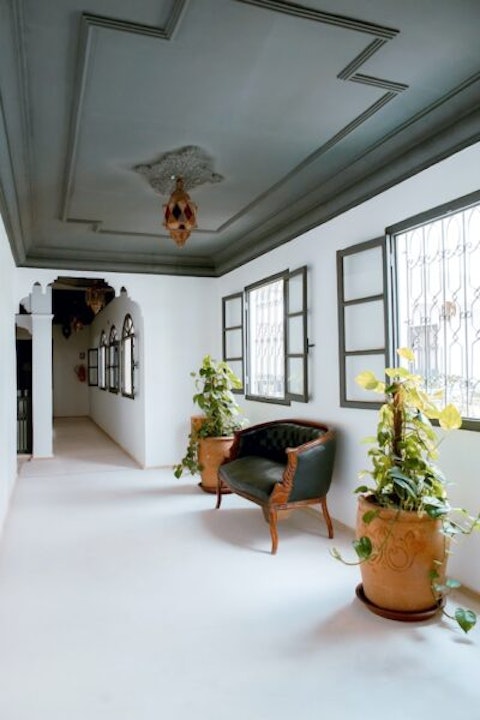
Photo by Toa Heftiba on Unsplash
Slide 6 also shows our fourth quarter adjusted EBITDA bridge versus the prior year. The 5% increase in adjusted EBITDA was driven primarily by favorable AUV performance, which was partially offset by increased levels of inflation, a decrease in volumes and lower equity earnings from our WAVE joint venture. Inflation headwinds remain, although natural gas prices softened in the fourth quarter. Raw material inflation remained the largest component of input cost inflation. Negative Mineral Fiber volumes were partially offset by another quarter of solid contributions from the AS segment. Mineral Fiber volume declines were driven by weaker market demand in the fourth quarter, in addition to lapping a strong prior year period in which some customers were buying ahead of a January 2022 price increase.
WAVE equity earnings were down 19% versus prior year and were negatively impacted by lower volumes as customer inventory corrections continued into the fourth quarter, partially offset by favorable AUV. On Slide 7, we summarize our Mineral Fiber segment results. Fourth quarter net sales increased 4% year-over-year driven by favorable AUV of 15%, which was partially offset by lower volumes of 10%. On AUV, we delivered favorable like-for-like pricing in the quarter, along with positive channel and product mix. Channel mix was positive as a result of lower relative sales to home center customers versus prior year. Product mix benefited from stronger sales of our higher-end SWAT products or smooth white acoustical tile. On volume, a large portion of the 10% decline was driven by the difficult comparison to the prior year quarter.
As we’ve discussed in prior calls, the fourth quarter of 2021 included the buy-ahead activity in advance of our January 2022 price increase. The remainder of the volume decline was driven by weakening market demand, primarily in the home center customer channel. As a reminder, home center volumes increased in the third quarter and drove negative channel mix and lumpiness in this particular sales channel is not uncommon. With strong price execution and moderating inflation, our price over inflation dollar realization sequentially improved over Q3. Mineral Fiber EBITDA in the fourth quarter grew 2%, as a result of the strong AUV performance and benefits from manufacturing productivity. In the quarter, our operations teams overdelivered manufacturing productivity with solid contributions across the plant network.
We also saw a benefit from lower SG&A on prudent cost control as we finish the year. These positives were partially offset by weaker volumes, continued input cost inflation and lower earnings from our WAVE joint venture. The Mineral Fiber EBITDA margin compression was more than explained by weaker WAVE earnings, partially offset by lower SG&A expense. As I mentioned, we were happy to see moderating energy inflation driven by natural gas pricing, but several of our key raw materials continue to see cost pressure, and we expect this to continue into 2023. On Slide 8, we discuss our Architectural Specialties or AS segment results. In the fourth quarter, we completed a tuck-in acquisition of GC Products, which is an attractive complement to our existing Plasterform architectural castings business and expands our geographic reach in this product area.
AS continued to perform well in the fourth quarter and delivered sales growth of 18% versus prior year. This marks the segment’s ninth consecutive quarter of double-digit year-over-year sales growth with 8 out of the last 9 delivering over 15% growth. By building the broadest product portfolio, enabling network efficiencies through AWI scale and channels to grow our product categories, we’re further penetrating the market and expanding margins. In fact, the AS segment delivered their fifth consecutive quarter of EBITDA margin expansion with Q4 expanding 60 basis points versus prior year. Driving the margin expansion was the fall-through from the top line, which was partially offset by increased manufacturing costs, in-line with higher sales.
SG&A expenses were slightly higher than the prior year, due to continued investments in support of increased sales growth. Slide 9 shows our full year consolidated company metrics. We drove net sales growth of 11%, while the EBITDA result of 4% growth was pressured by inflation, an increase in SG&A and lower WAVE equity earnings. The majority of the contraction in EBITDA margin was driven by the negative WAVE results. Adjusted diluted earnings per share increased 9% and adjusted free cash flow increased by 16%. Looking at the full-year EBITDA bridge, favorable AUV and positive volumes were partially offset by higher inflation, increased SG&A expenses primarily related to the investments and company-wide growth initiatives, including AS sales growth and lower WAVE equity earnings.
Slide 10 shows full-year adjusted free cash flow performance versus the prior year. The 16% increase in adjusted free cash flow resulted primarily from an increase in WAVE dividends, which includes a $25 million special dividend. The WAVE Board of Directors periodically reviews the capital structure and net debt leverage of the joint venture, and returns excess cash to the parent companies. In addition to the WAVE special dividend, higher cash earnings and lower spend on capital expenditures provided free cash flow benefit. That benefit was partially offset by timing-related net negative working capital impacts. Cash interest was a headwind versus the prior year due to the rising interest rate environment throughout 2022. Returning cash to our shareholders through share repurchases and dividends is one of the 3 pillars of our capital allocation strategy and we continued to deliver on this in 2022.
In the fourth quarter, we repurchased $20 million of shares, which brings our full-year share repurchase total to $165 million. Since the inception of the share repurchase program in 2016, we have repurchased 12.4 million shares or more than 20% of outstanding shares at the time of the authorization for a total of about $851 million. When including our dividend payments, we have returned over $1 billion to shareholders through both share repurchases and dividends since 2016. In addition, we increased our quarterly cash dividend by 10% in the fourth quarter. Slide 11 shows our full year 2023 guidance. We are focusing on delivering sales and earnings growth in a challenging macroeconomic environment. Our guidance assumes a weaker market in 2023 with pressure most pronounced in the back half of the year.
We expect consolidated net sales growth in the range of 2% to 6% and adjusted EBITDA growth in the range of 3% to 9%. We expect challenging macroeconomic conditions to weigh on market demand, partially offset by positive contributions from our initiatives, netting a mid-single-digit decline in Mineral Fiber volumes year-over-year. We expect above average Mineral Fiber AUV growth with historical fall-through rates. We expect positive WAVE equity earnings versus the prior year, rebounding from 2022 results. Additionally, as part of our normal operating rhythm of assessing investments and their returns, we have decided to pull back investment related to one of our digital growth initiatives. As a result of this decision, we have initiated a headcount reduction and restructuring plan that Vic will explain in more detail shortly.
These actions are expected to deliver annual SG&A savings of about $6 million, primarily realized in the second half of the year. To close out the discussion on our 2023 guidance, adjusted EPS is expected to grow in the range of 1% to 7%, and adjusted free cash flow is expected to grow in the 4% to 13% range, driven by higher cash earnings and working capital benefits. Additional assumptions are available in the appendix to this presentation. And while we don’t provide quarterly guidance, we expect first quarter Mineral Fiber input cost inflation to be temporarily impacted by a $4 million to $5 million headwind related to inventory valuation timing. This will weigh on Mineral Fiber EBITDA margins in the first quarter, but will be less impactful throughout the rest of the year.
And now, I’ll turn it back to Vic for some additional thoughts before we take your questions.
Vic Grizzle: Thanks, Chris. As Chris referenced, we’re planning for further economic weakening in 2023 and have taken a thoughtful look at our organization. Our growth investments and all the levers in our control to ensure we deliver consistent profitable growth. As a result, in January, we trimmed our workforce in an effort to size our organization to the market conditions we expect to see in 2023, this has also included stopping an investment in one of our digital growth initiatives related to sales lead optimization. While we’ll continue to use the tool, our team has built thus far, we will not be investing to further expand and enhance it at this time. We also took the opportunity to streamline our sales management organization for efficiency, and to further manage Mineral Fiber and Architectural Specialty sales effectively as one face to the customer.
This is an important point of leverage that delivers the competitive advantage of Armstrong’s size, scale, and breadth of capability. We are continuing to invest in Canopy by Armstrong, Project Works and Healthy Spaces as each of these initiatives are meeting their investment case and unlocking new sources of demand. With the gains these initiatives are providing we are improving we can outperform market demand and further strengthen our competitive position and our Healthy Spaces initiative, specifically, the Mineral Fiber Healthy Spaces portfolio grew double digits in 2022, while most Mineral Fiber products declined. This is because the need for cleanable antimicrobial products continues to grow, and the Armstrong’s portfolio of products is unmatched in the industry.
In addition, our StrataClean IQ product line that was launched in the second half of 2022 is gaining traction in the market and winning awards for product innovation. And just recently, we advanced our commitment to leading the movement toward healthier spaces by signing the White House and EPA’s Clean Air in Building Challenge. On the digital front, Canopy by Armstrong delivered quarter-on-quarter growth throughout 2022. Our intent from the beginning has been to create new sales opportunities from latent demand in the large installed base of mineral fiber ceilings. And from our survey work, we are seeing validation of our proof points. Surveys of customers in 2022 indicated that nearly 50% of customers buying on Canopy today have never purchased an Armstrong product before using the Canopy website.
And a third of the customers were renovating ceilings and buildings that are less than 10 years old. Now, that’s well above the national average. Again, validating that Canopy is providing something missing in the marketplace and creating new demand. We are encouraged with 2022 results, and we expect 2023 to be a continuation of the strong growth trend. And importantly, we expect Canopy to contribute positive EBITDA growth for the full-year. ProjectWorks, our automated design service has also made important progress in 2022 by expanding the number of AWI products on its design platform, and increasing its speed and turning project designs into drawing packages that simplify ordering and installation. Throughout the year, the ProjectWorks team more than doubled the number of projects and shortened the turnaround time to less than three days.
The time savings, along with an accurate bill of goods and installation instructions that eliminate waste on the job site are key value propositions to our customers that strengthen our relationships with contractors and the architect and design community. Our growth investments have also included increasing the selling and manufacturing capabilities in our rapidly growing Architectural Specialties business. These investments have supported the strong growth we delivered in 2022 and sets us up for solid growth in 2023, despite a weaker market. The power of focus we have in the ceilings and specialty wall sector is unlike existing players in this category. And with the key relationships we’ve developed across the value chain here with designers and architects, to the general contractors, to distributors, we are best positioned to win both small and large statement basis.
Our unique ability to invest in these initiatives is enabled by the overall resilience of our free cash flow generation, supported by the attractive fundamentals of the Mineral Fiber segment. We expect to continue delivering solid free cash flow growth in 2023 and we will look for attractive opportunities to further invest in complementary strategic acquisitions, as well as back into our existing operations, consistent with our established capital allocation priorities. And beyond this, as Chris said, we’ll continue our commitment to return value to shareholders through our cash dividends and our share repurchases. Finally, I would like to say thank you to the entire Armstrong team for their tireless efforts and what turned out to be a more challenging year in 2022.
I remain confident that we have the right people and the right places to lead our company forward in 2023 and beyond. With our strong team, our focus on profitable growth, and our unique position in an attractive industry category, we have the ability to consistently deliver results through all parts of the economic cycle. And with that, now we’ll be happy to take your questions. And I hand it back to the operator.
See also 30 Poorest Countries in Africa and 12 High Growth Healthcare Stocks to Buy.
Q&A Session
Follow Armstrong World Industries Inc (NYSE:AWI)
Follow Armstrong World Industries Inc (NYSE:AWI)
Operator: Thank you. Our first question comes from Susan Maklari with Goldman Sachs. You may proceed.
Susan Maklari: Thank you. Good morning. everyone.
Vic Grizzle: Good morning, Susan.
Susan Maklari: Good morning. My first question is, you know thinking about the pricing in the Mineral Fiber segment, you’ve obviously seen a lot of success there over the last couple of years actually in this inflationary environment. As you think about 2023, can you talk a bit of the ability to continue to get incremental pricing through? And how much of the gains you’re expecting for this year reflect carryover versus potentially moving back to a more normalized cadence of pricing?
Vic Grizzle: Yes. Susan, the backdrop to that clearly is, as Chris mentioned, a continuation of the inflationary environment. We expect a tail on this inflationary curve given and a lot of companies are probably in a situation where they are protected under contracts in 2022. And as those contracts roll over, there’s some catch-up in some of the inflation or in those contracts in terms of inflation. And that’s exactly, I think, the condition we’re going to be in. We’re going to see some although some rolling over of certain inflationary items in both our raw materials and energy. We are going to see some additional inflation from contracts that have rolled over and are now repriced. So, I think again, a lot of companies are in that.
So, we’re going to be in an inflationary environment where, to your question, the incremental pricing is going to be really important for us. With that said, I hope for us, and our plan is at this point, to get back to a regular cadence on our price increases. So, one in February and then one in August, get back to our cadence of two price increases a year. We’ve already priced our first one at 8%, and we’re expecting to get good realization really our normal realization on that with the carryover that you’re referencing. I think we’re going to have some again, historically, normal carryover rates going into the year that’s going to support foundationally the price realization we need to have to expand margins in 2023. And that’s our plan.
You can see it in our outlook that the incremental pricing with the carryover, the gains from a more regular price increase cadence to deliver margin expansion in the fall-through.
Susan Maklari: Okay. That’s very helpful. And then thinking a bit about the office . Clearly, you talked about some of the weakness that you’re seeing there. That’s been an area that’s been a little slower to come back relative to some of the other sectors that you cover in there. How do you think about that, that space in the broader sense? What’s going to get that to finally sort of kick in there, where we can really see some of those investments coming through? And how do you think about that in relation to your ability to really grow volumes in the business over time?
